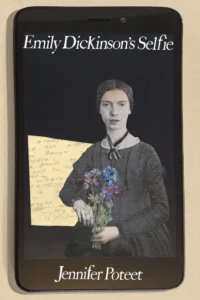Jennifer Poteet. Emily Dickinson’s Selfie. Bottlecap Press, 2023. 23 pages. $10.00
I don’t think I’ve ever had so much fun reading a collection of poetry as I have with Jennifer Poteet’s chapbook, Emily Dickinson’s Selfie. I don’t mean that the poems are simply funny, although some of them are funny, but that what Poteet is able to do with voice and style is surprising, impressive, and delightful. In this collection, each poem adopts the style of another earlier poet, from Gertrude Stein to Walt Whitman, from Sappho to Robert Hayden, incorporating 21st century icons—from the selfies of the title to Trader Joe’s and Botox and GPS and Uber—in order to re-imagine these other accomplished poets. These poems are not the parodies we see so often of Williams’ “This Is Just to Say” or the variations of Stevens’ “Thirteen Ways of Looking at a Blackbird.” They are each their own poems, adeptly incorporating the voice of the poet under consideration, so that, for example, the rhyme in “GPS on a Snowy Evening,” alluding to Frost’s “Stopping by Woods on a Snowy Evening,” is entirely different from the rhyme in “Two Women in the Snow,” an homage to Plath. The fun for me in this collection occurs not only because Poteet is so skilled, and obviously well-read, but also because the content of each poem is just right, clearly but subtly enough incorporating details from the biographies or content of their own poems. We see Walt Whitman, therefore, at a Trader Joe’s rather than the supermarket of his own poem, and we read of Williams considering Covid.
Here is the opening poem, “Gertrude Stein Logs in to Yahoo! Mail”:
A password is a password
is a password. If I could only
remember mine, could I.
I tried Picasso; I tried Matisse.
After three times why
after three times why
does Yahoo! lock you out?
Maybe Alice remembers
what my password is.
She’s baking something in the kitchen
but yells out for me to try
Toklas this time.
Alice, without whom I cannot breathe.
Tender Alice B. Alice be Alice.
Toklas works.
On its surface, this poem conveys an experience we’ve all had, adapting to the inconvenience of modern convenience. The poem incorporates Stein’s stylistic gestures, the repetition, the incomplete sentences, the associative logic, so that even if the names were not present in the title and poem itself, we would recognize this language as a reference to Stein. Yet it is also more than that. There’s a turn near the end, as Alice becomes more than a background figure who keeps the household running, as Gertrude’s feelings for Alice are revealed as so much more profound than mere wordplay. In an extended analysis, I could say so much more about the thematic depth of this poem, its exploration of inclusion and exclusion and the nature of socially scorned relationships, but a short review is not the place for that type of reading. The potential fruitfulness of such a reading, however, supports my point that these poems are fun and also serious literature.
Here are a few lines from “Two Women in the Snow”:
We hum. We’re schoolgirl chums.
We’re two jolly gravediggers.
Sylvia says she wants to melt as snow does.
As for the piles we make,
I think they look like brides,
eager to shed their white satin dresses.
And here are a few lines from “On a Winter Sunday I See Robert Hayden in Shop n’ Save”:
I come up short and as I ask the cashier
if I can put some items back,
he slips me a fifty dollar bill
and disappears before I can thank him.
And from “Emily Dickinson’s Selfie”:
I take a secret picture
after pressing the last summer flowers.
In a long white dress and Birkenstocks
I dance, in grass, for several hours—
Each poem is uniquely executed, the craft choices smart and controlled. Most of us could probably write one or two poems in the voices of other poets whose work we know well. Very few of us, I suspect, could exhibit such a range—our own stylistic tics would eventually get in the way. Poteet’s range is what impresses me most. Emily Dickinson’s Selfie is her second chapbook. I hope we’ll be seeing many more collections from her.
